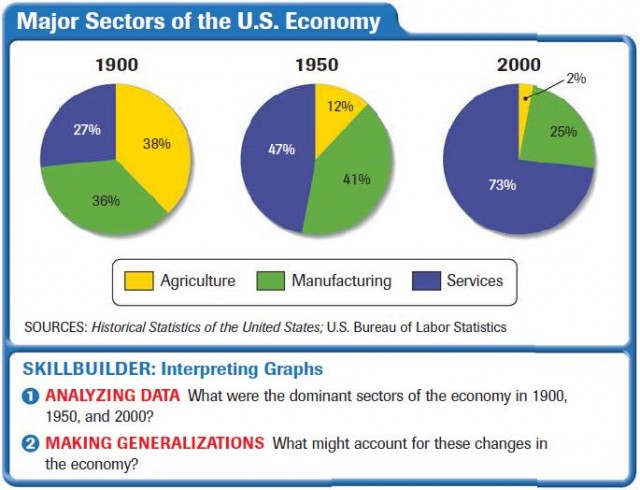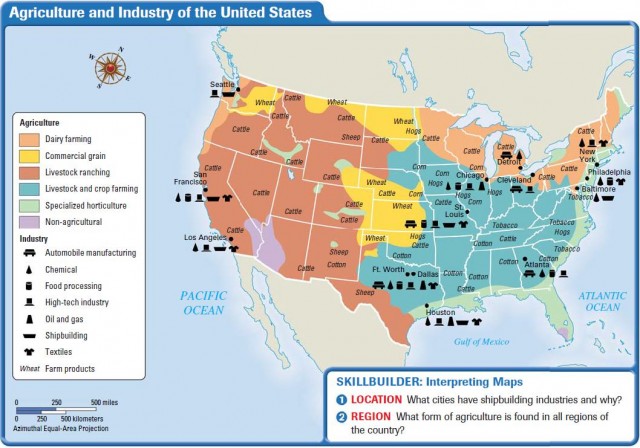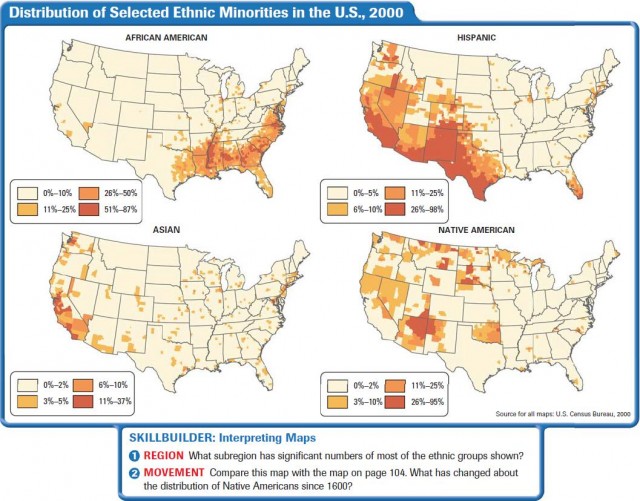Economy and Culture of the United States
A HUMAN PERSPECTIVE The average American worker in 1790 was a self-employed farmer. The farmer spent each work day, sunrise to sunset, in backbreaking labor in the field. Most of the crops and livestock raised were consumed by the farm family. In the 1890s, the average American worker labored in a manufacturing or service industry, for long hours and low wages, often under unsafe conditions. Laborers in factories, for example, worked 60 hours a week for a total wage of $12; some were as young as 12 years of age.
At the start of the 21st century, the average worker was spending most of the workday in an office in front of a computer, processing information or providing services. The standard workweek was 40 hours; the government regulated workplace safety; and salaries generally covered living expenses, leisure-time activities, and perhaps, even savings.
The World's Greatest Economic Power
The United States has about 7 percent of the world's land area and about 5 percent of the world's population. But it has the world's largest economy—the most powerful, diverse, and technologically advanced in the world. The United States is a world leader in agricultural products, manufactured goods, and global trade. In fact, it accounts for more than 10 percent of the world's exports, which are goods sold to another country.

Three factors have contributed to the overall success of the American economy—available natural resources, a skilled labor force, and a stable political system that has allowed the economy to develop. The economy is run largely on free enterprise. In this economic system, private individuals own most of the resources, technology, and businesses, and can operate them for profit with little control from the government.
AN AGRICULTURAL AND INDUSTRIAL GIANT
The United States not only feeds itself but also helps to feed the world. American farms and ranches supply about 40 percent of the world's production of corn, 20 percent of its cotton, and about 10 percent of its wheat, cattle, and hogs. Fertile soil, a favorable climate, and the early mechanization of the country's farms are mainly responsible for this bounty. Different areas of the country produce different products, as you can see from the map on this page. The Midwest and South, for example, specialize in crop farming, while livestock ranching is concentrated in the West.
The industrial output of the United States is larger than that of any other country. Advances in technology, especially in electronics and computers, revolutionized industry and led to the creation of new products and methods of production. Leading industries are petroleum, steel, transportation equipment, chemicals, electronics, food processing, telecommunications, consumer goods, lumber, and mining.

Major industrial centers have long been located along the Atlantic Coast and around the Great Lakes. In recent decades, a variety of industries have also started up in urban areas in the South and along the Pacific coast. Over time, some areas have become associated with certain products, such as Detroit (automobiles), Seattle (aircraft), and northern California, in an area called Silicon Valley (computers).
A POSTINDUSTRIAL ECONOMY
The graphs on page 140 show the rich farming and manufacturing traditions of the United States. But they also indicate that the American economy today is driven by service industries. A service industry is any kind of economic activity that produces a service rather than a product. Nearly three out of four Americans now work in service-related jobs, such as information processing, finance, medicine, transportation, and education. This economic phase is called a postindustrial economy, one where manufacturing no longer plays a dominant role.
The United States is the world's major trading nation, leading the world in the value of its exports and imports. It exports raw materials, agricultural products, and manufactured goods. Automobiles, electronic equipment, machinery, and apparel are some of its principal imports. Its North American neighbors, Canada and Mexico, are two of its most important trading partners. Many American corporations engage in business worldwide and are called multinationals.
A Diverse Society
Because the United States is a nation of immigrants, it is a nation of different races and ethnic traditions. The majority of Americans, about 70 percent, trace their ancestry to Europe. Hispanic Americans, mainly from Central and South America, make up about 13 percent of the population; African Americans, about 12 percent; Asian Americans, 4 percent; and Native Americans, 1 percent. The largest ethnic groups are English, German, Irish, African, French, Italian, Scottish, Polish, and Mexican. The maps on page 142 show the distribution of some groups.

LANGUAGES AND RELIGION
English has been the dominant language of the United States since its founding. Spanish is the second most commonly spoken language. Typically, immigrants have spoken their native language until they learned English.
Religious freedom has been a cornerstone of American society. Today, more than 1,000 different religious groups practice their faiths in the United States. By far, the majority of the American people—85 percent—are Christians. About 56 percent are Protestants and 28 percent Roman Catholics. Jews and Muslims each account for about 2 percent of the religious population.
THE ARTS AND POPULAR CULTURE
The United States has a rich artistic heritage, the product of its diverse population. Its first artists were Native Americans, who made pottery, weavings, and carvings. Early European settlers brought with them the artistic traditions of their homelands. Truly American styles developed in painting, music, literature, and architecture in the 19th century. Artists depicted the country's expansive landscape and scenes of American life both on the western frontier and in the cities. One 19th-century American creation, the skyscraper, changed urban architecture all over the world.
Today, motion pictures and popular music are two influential American art forms. Hollywood, California, is the center of the movie industry in the United States. American films provide entertainment for the world. Many ethnic groups contributed to the musical heritage of the United States. For example, jazz, blues, gospel, and rock 'n' roll have African-American origins. Country and bluegrass music developed among Southern whites whose ancestors came from the British Isles.
American Life Today
More than 280 million people live in the United States. The majority enjoy a high standard of living. Despite coming from many ethnic and racial groups, they generally live and work together. They are pursuing what attracted their ancestors to the New World and came to be called “the American dream,” a better life for themselves and their children.
WHERE AMERICANS LIVE
About 80 percent of Americans live in cities or surrounding suburbs. Americans moved first from rural areas to cities and then from cities to suburbs. The shift to the suburbs was made possible by the widespread ownership of automobiles. There is one auto for every 1.3 Americans. A highly developed transportation network that includes highways, expressways, railroads, and airlines aids mobility.
HOW AMERICANS LIVE, WORK, AND PLAY
Nearly 50 percent of American adults of working age are employed. Almost half of them are women. As you read earlier, about seven out of ten Americans in the workforce hold service industry jobs.
Many are highly skilled positions, which require advanced education. Americans have always valued education, seeing it as a means to provide equality and opportunity. As a result, all children from the ages of 6 or 7 to age 16 are required to attend school. Nine out of ten students are in the public school system, where education is free through secondary school. The United States also has more than 2,300 four-year public and private colleges and universities.
Americans have a wide range of choices for leisure-time activities. As either spectators or players, they take part in sports such as baseball, basketball, football, golf, soccer, tennis, and skiing. Most major cities have professional sports teams. Americans of all ages also use their free time to engage in hobbies, visit museums and libraries, and watch television and movies. Another favorite activity is spending time on the computer, surfing the Internet or playing video games.
Unfortunately, not all Americans live well. More than one in ten lives in poverty. It is a continuing challenge for government and society to try to bring these people into the mainstream of American life. In the next section, you will learn about life in the country's subregions.